External section is a new addition and it is specific to PBXware SP edition.
External section allows us to inspect and edit PBXware elements located on external PBXware systems synced with our PBXware SP. These elements include systems, tenants, extensions and DIDs. In addition, we can also inspect logs related to syncing these elements between PBXware SP and external systems syncing with it.
NOTE: When accessing a remote system using PBXware SP’s SSO (Single-Sign-On) feature, the username displayed in the PBXware interface will be SP User instead of Administrator to inform users of how they are accessing the external system. In addition, any changes made on the external system will be assigned to the SP User on the Action Logs page.
Although you will have most of the permissions of the PBXware Administrator account, Account Settings will be disabled when you are logged in as an SP User, preventing you from changing the password or setting up 2-factor authentication. You must log in to the remote system directly to make these changes.
.
¶ Systems
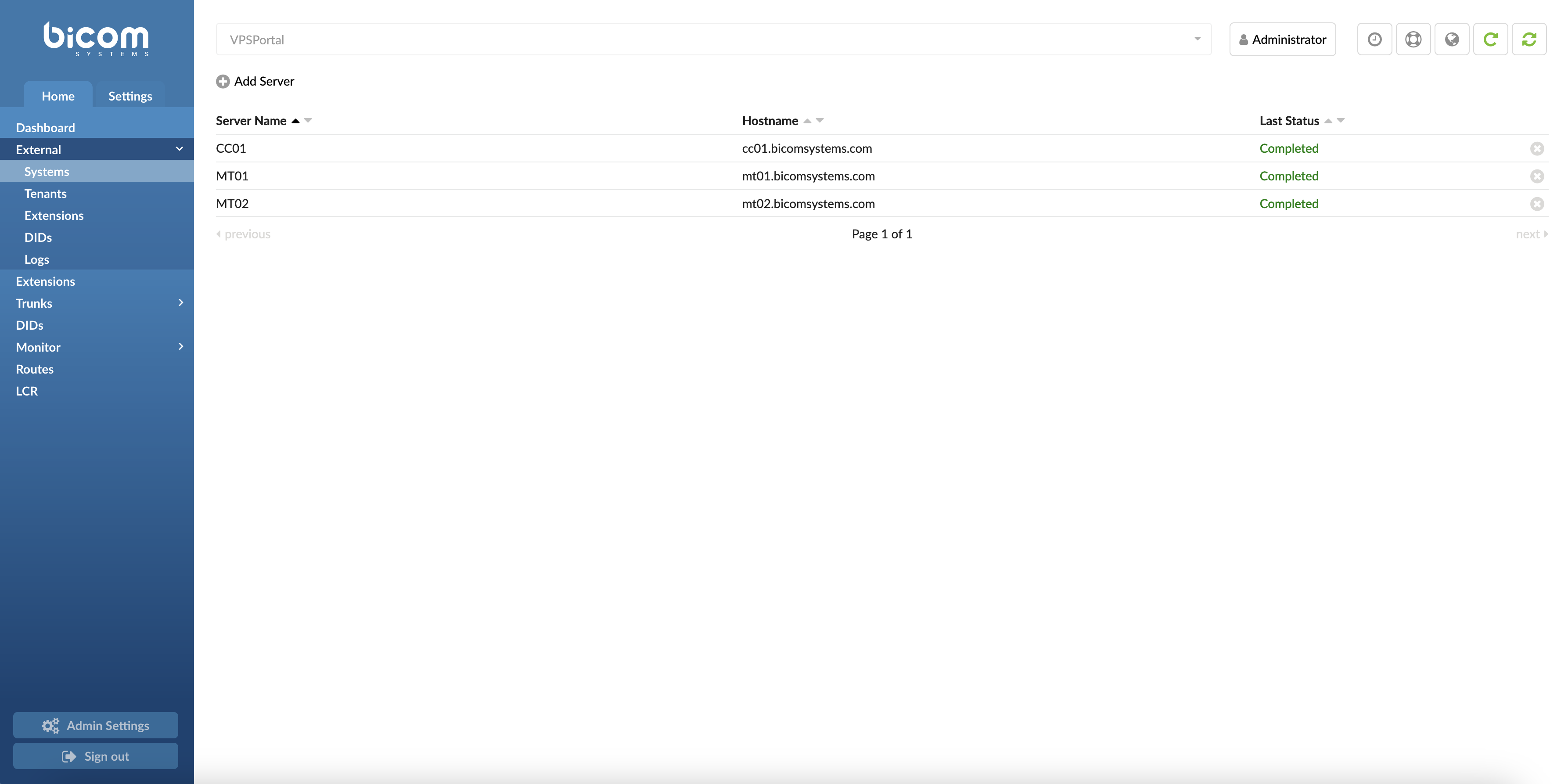
Systems section allows us to add external systems to PBXware SP and sync aformentioned data. In addition, it also provides information on initial sync status for each external system as well as option to remove the system and all its data from PBXware SP.
- Server Name
Name of external server syncing with PBXware SP platform.
Although Server Name is arbitrary, and is created during addition of new external system, it is advised to use recognizable name for server you are adding, to avoid any confusion in the future.
- Hostname
IP address/Hostname of external PBXware system syncing with PBXware SP.
- Last Status
Current status of initial sync with external server.
When new external server is added, assuming connection with server was established successfully, initial sync will start and Last Status should be displayed as In progress. Please note, Systems page is not refreshed automatically so in order to get the Last Status updated after you add the new server, you will need to manually refresh the page.
Even on servers with large number of extensions, sync should not take longer than couple of minutes and in case status does not change to Completed in that timeframe, make sure to check Logs page for eventual sync issues.
.
¶ Adding new server
To add a new server, click Add Server button in the upper left corner of the page.
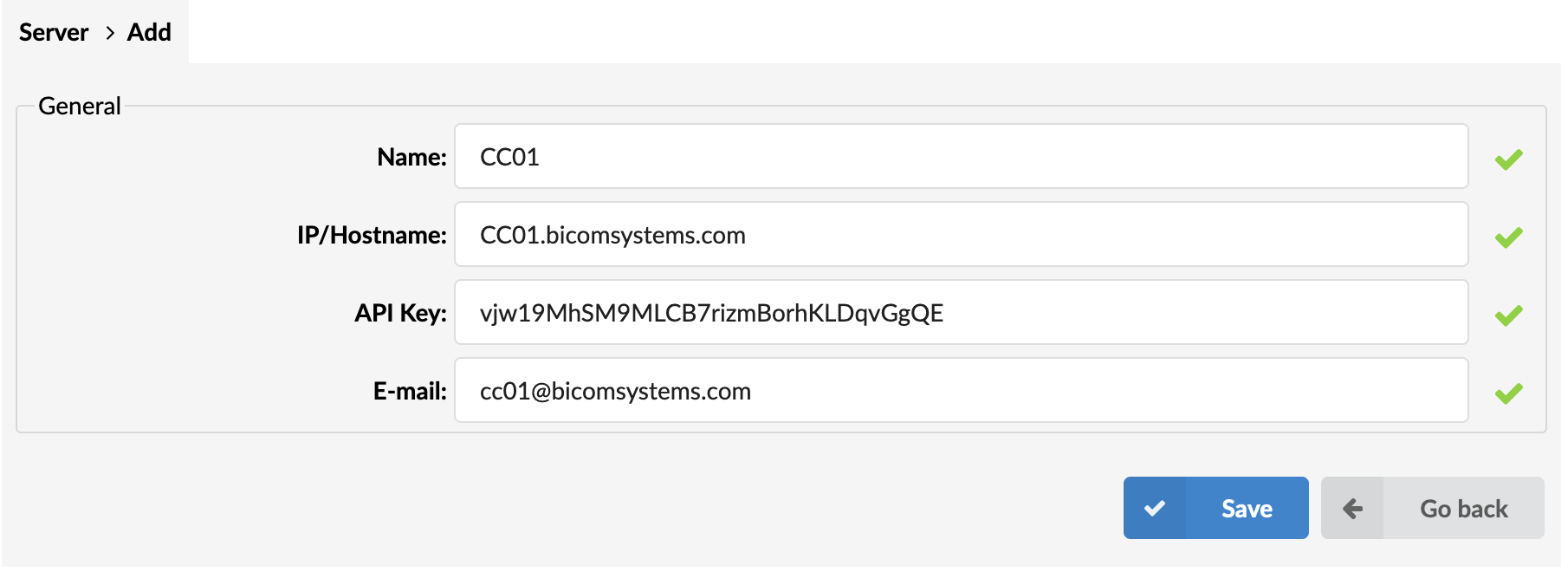
Once Add window is opened, we will need to populate several fields in order to add new PBXware to your SP platform:
- Name
Recognizable name of the External System you are adding
- IP/Hostname
IP address/Domain name server can be reached at i.e. mt01.bicomsystems.com
NOTE: At this moment, IP address can be used for adding external systems and syncing data from them, however this comes with a major downside. Although you will still have an overview of all the synced PBXware elements located on external system added with IP, unless domain name is used, you will not be able to edit these elements from PBXware SP interface.
- API Key
API key used for authenticating remote connection to the system you are adding.
Please note, in order to complete the setup you will first need to create a new API key on remote PBXware and paste it into this field. Although it is not necessary to create a dedicated API key for this use, it is strongly advised to do so.
In case you previously enabled Auto-Setup for Call Routing, this e-mail address will be used for creation of a Multi-user extension on PBXware SP.
.
¶ Tenants
Tenants page provides a direct access to the System, Master Tenant and Tenants settings for all external systems synced with PBXware SP, as well as ability to modify their settings if needed, just as if you are logged into external system directly.
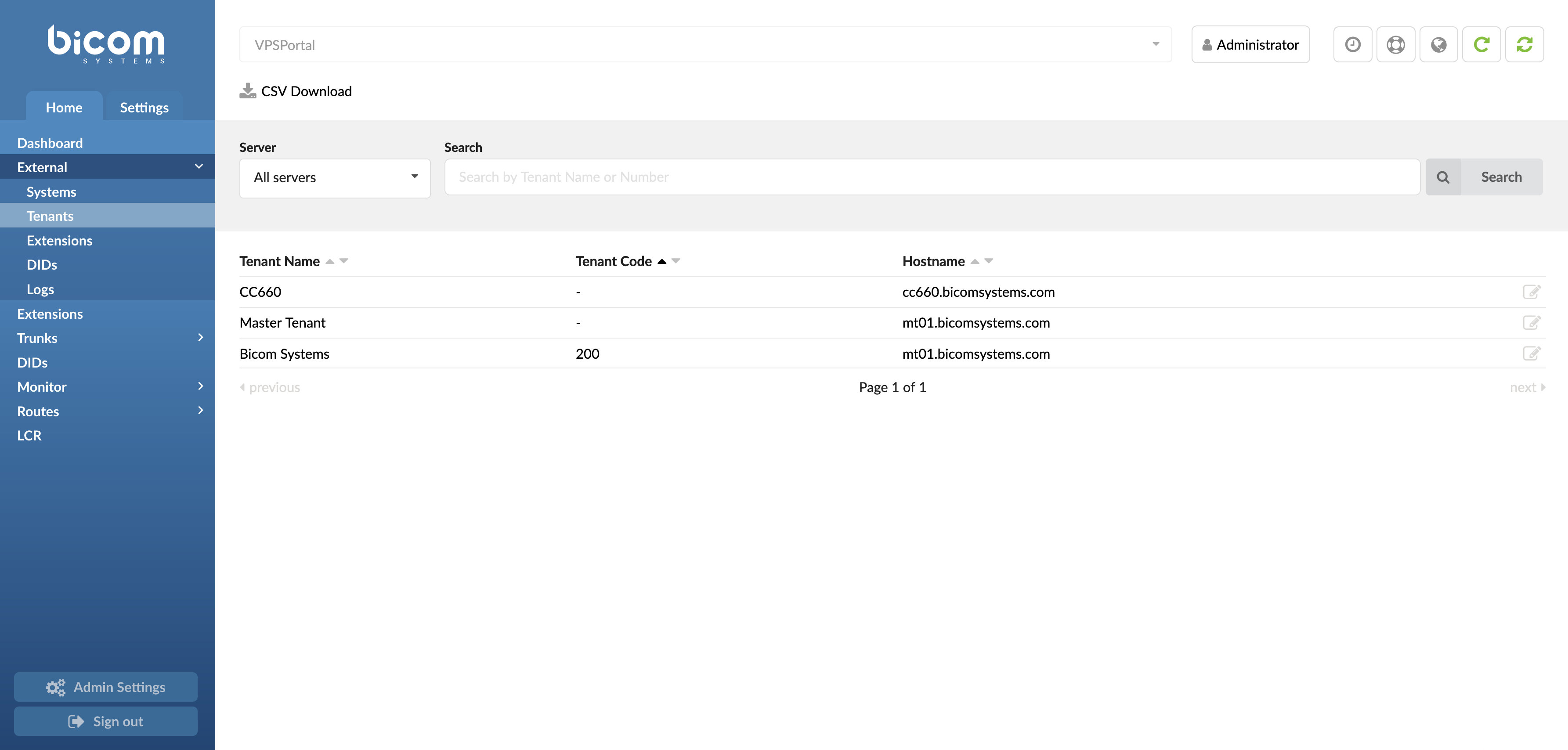
- Server
Select server name from the drop down list to filter System settings for that external server, or in case of an MT system, to display settings for Master Tenant as well as every individual Tenant available on that external PBXware system.
- Search
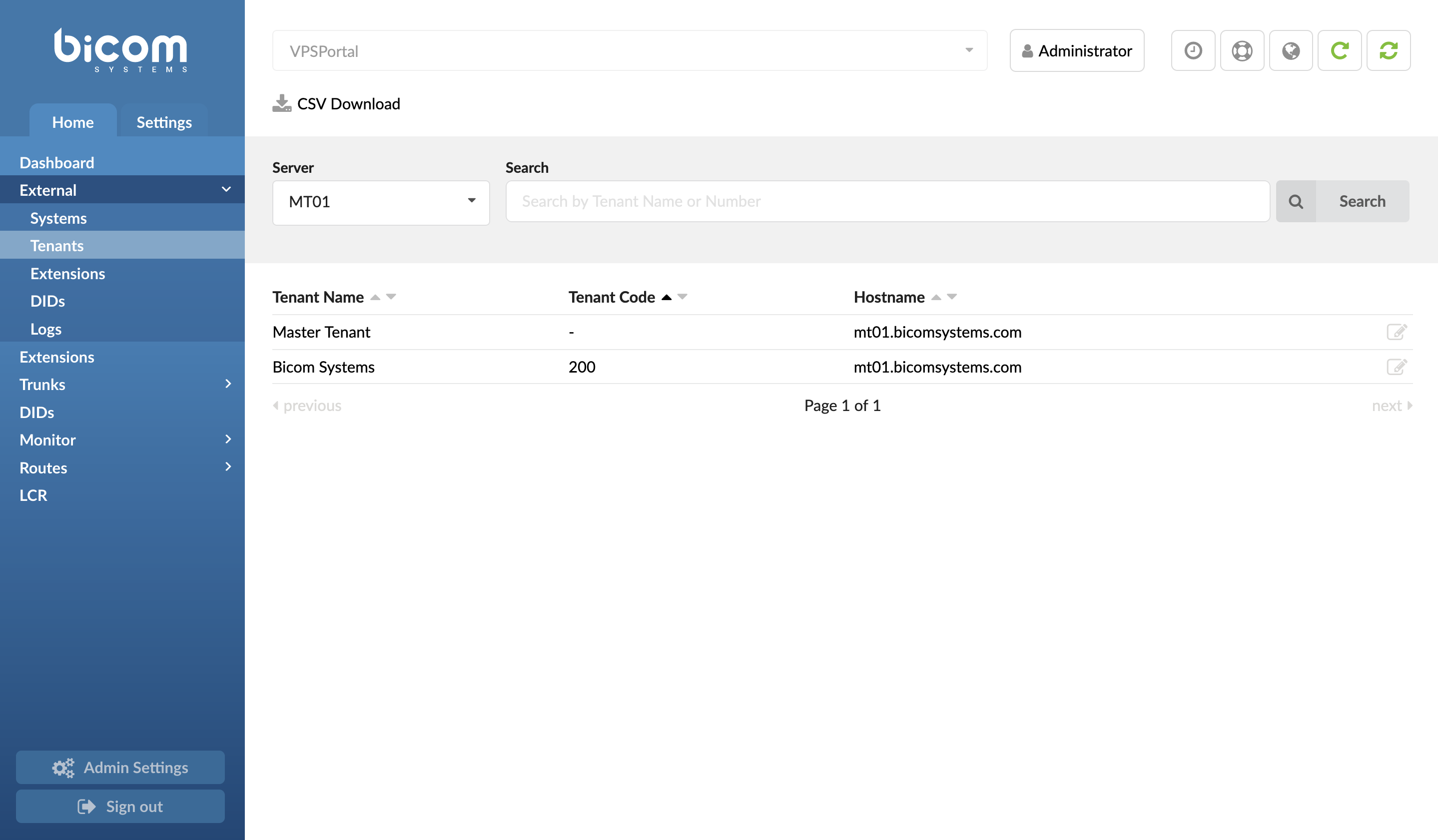
To further narrow the search results, enter a text pattern into the search field and press enter on your keyboard or Search icon to perform the search. For example, enter number 200 into the search field to only display tenants with tenant ID 200. Unless specific server is selected from the drop down list, search results will include tenant 200 from all external systems, but it will also include any system and hostname that might have number 200 in its name.
- Tenant Name
Name of tenant as assigned on external system when tenant was created. This information is synced from external system.
- Tenant Code
Tenant number as assigned on external system when tenant was created. This information is synced from external system.
- Hostname
IP/Hostname of external PBXware System/Master Tenant/Tenant settings are located on.
Clicking the edit icon will open Server, Master Tenant or Tenant settings, in new tab, allowing you further inspection or editing of settings on external system.
For detailed information about settings for Master Tenant and Tenants, please check Tenants section of our PBXware 6 MT Admin Manual.
For detailed information about Server settings, please check Servers section of our PBXware 6 CC Admin Manual.
.
¶ Extensions
Extensions page provides a list of all extensions created on external systems synced with PBXware SP, with ability to filter the list of extensions and of course ability to edit them.
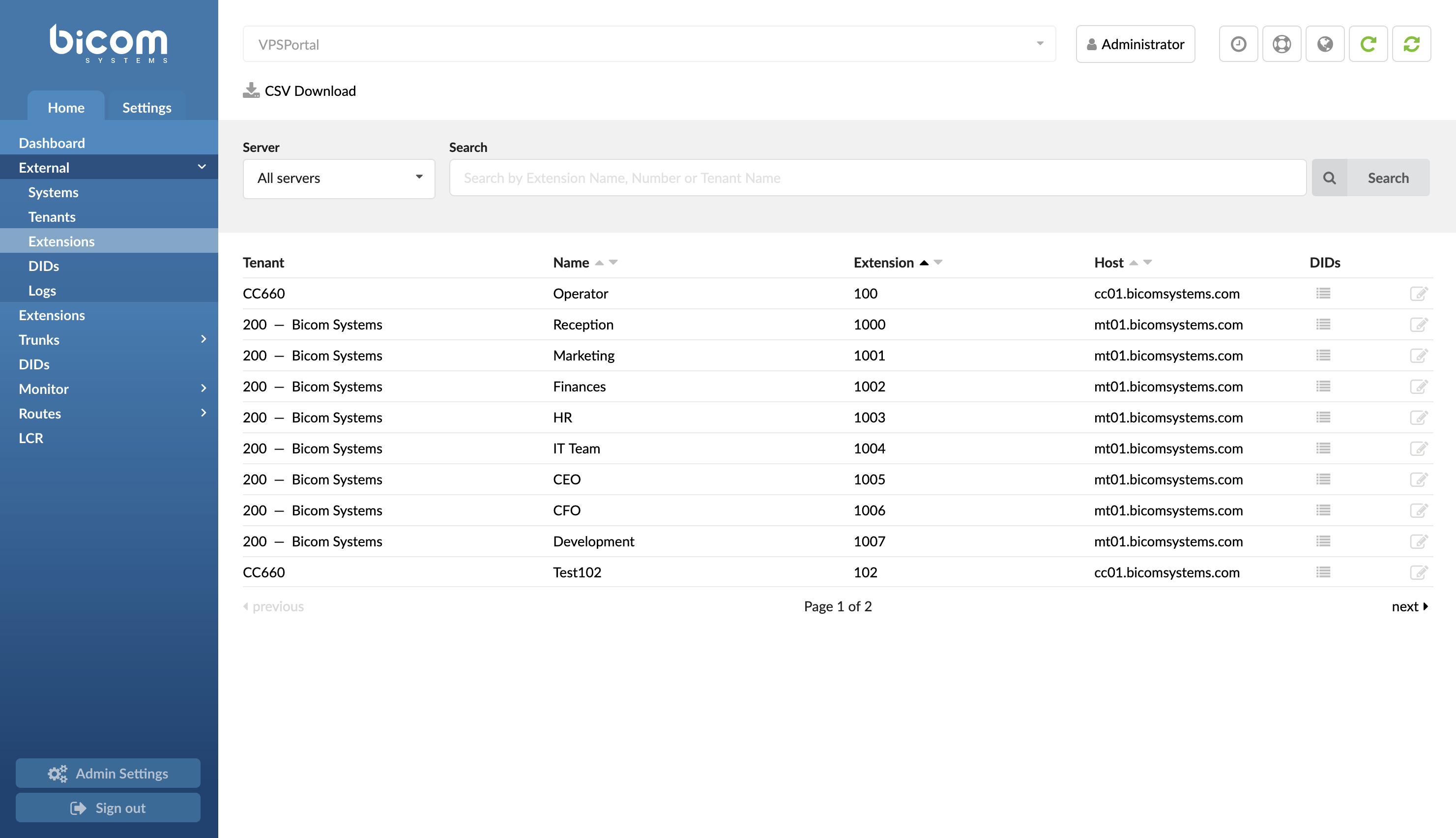
.
CSV Download option allows you to download CSV file with the list of extensions synced with PBXware SP from external systems. Although this file cannot be used to re-create these extensions it is still useful for creating an internal list of extensions.
- Server
Select server name from the drop down list to list the extensions from specific external server.
- Search
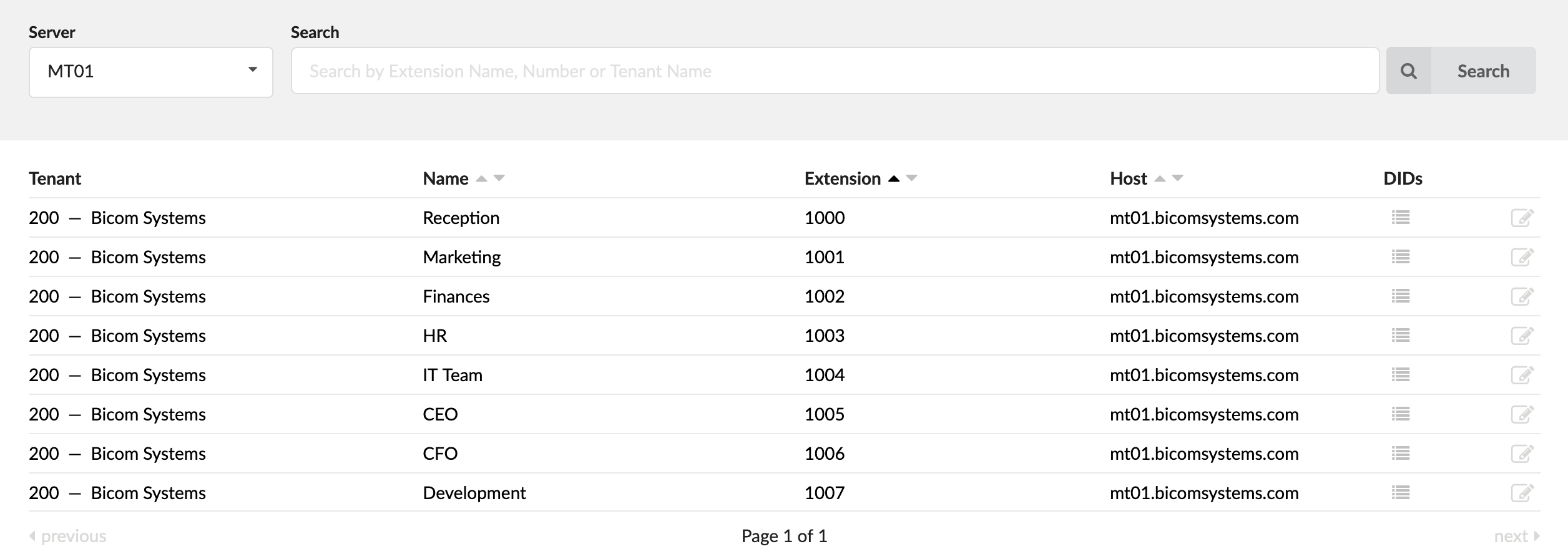
To further narrow the search results, enter a text pattern into the search field and press enter on your keyboard or Search icon to initiate the search. For example, enter number 200 into the search field to only display extension numbers starting with 200 (i.e. 200, 2000, 2009 etc). Unless specific server is selected from the drop down list, search results will include extensions starting with 200 from all external systems.
- Tenant
Tenant or System name, in case of non-MT edition, extension is located on.
- Name
Name of the user or department extension is assigned to.
- Extension
Extension number, number you need to dial to establish the call with extension operator.
![]()
By performing a mouseover on ![]() icon you will be presented with a popup, which includes information on DID number(s) associated with that extension.
icon you will be presented with a popup, which includes information on DID number(s) associated with that extension.
![]()
In case extension has no DIDs associated with, popup will display a message "No DIDs set"
Clicking on edit icon will open extension's settings in new tab, and allow you to further inspect or edit the extension on external system, without need to log in.
For detailed information about Extension's settings on PBXware Multi Tenant, please check Extensions section of our PBXware 6 MT Admin Manual.
For detailed information about Extension's settings on non-MT editions of PBXware, please check Extensions section of our PBXware 6 CC Admin Manual.
¶ DIDs
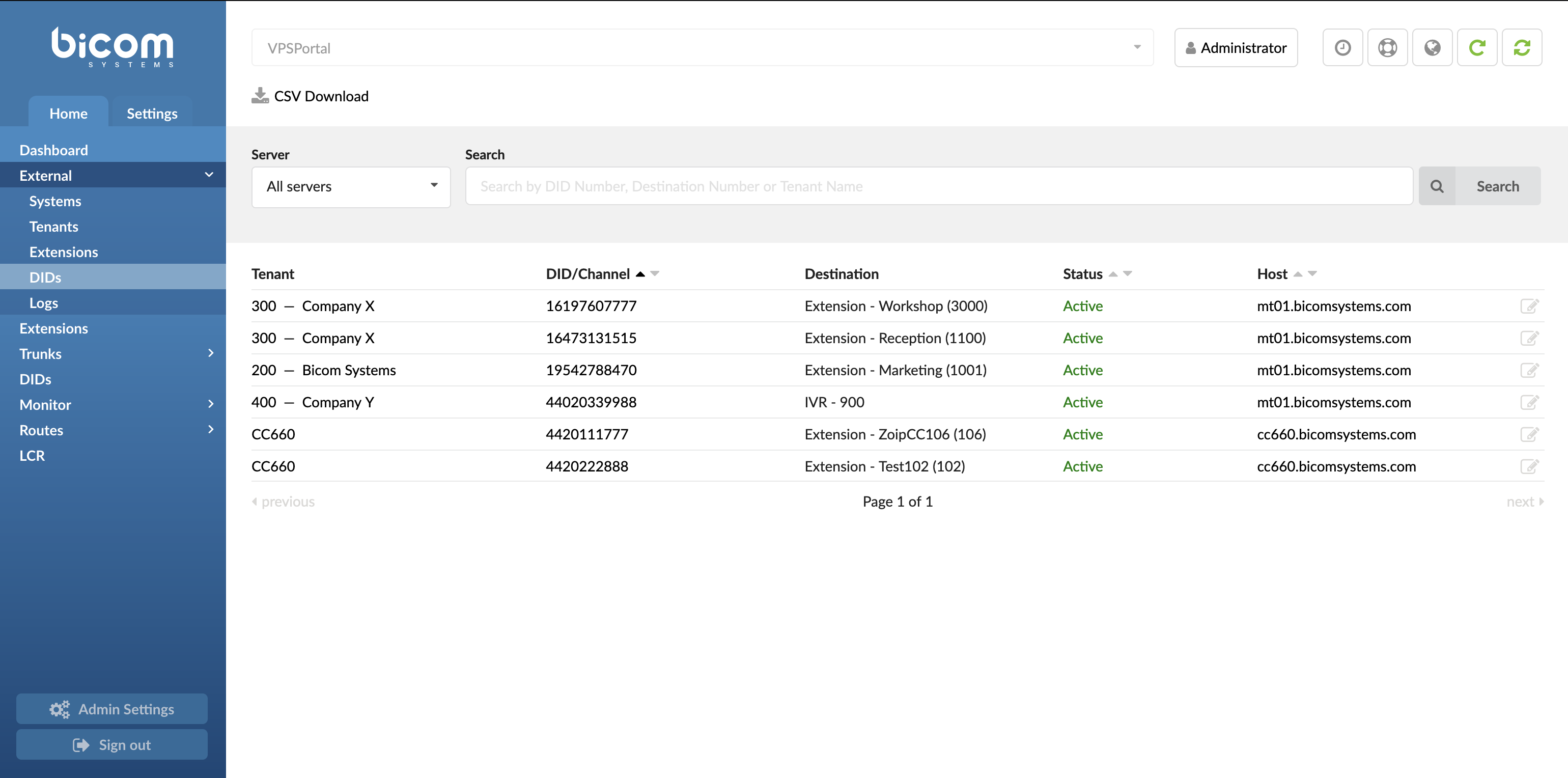
DIDs page provides a list of all DIDs created on external systems synced with PBXware SP, with ability to filter the list of extensions and of course ability to edit them.
.
CSV Download option allows you to download CSV file with the list of DIDs synced with PBXware SP from external systems. Although this file cannot be used to re-create these DIDs it is still useful for creating an internal list of DIDs.
- Server
Select server name from the drop down list to list the extensions from specific external server.
- Search

To further narrow the search results, enter a text pattern into the search field and press enter on your keyboard or Search icon to initiate the search. For example, enter number 200 into the search field to display System, Tenant names and DID destinations starting with 200 (i.e. 200, 2000, 2009 etc). Unless specific server is selected from the drop down list, search results will include matching results from all external systems.
- Tenant
Name of external System/Tenant DID is located on.
Clicking on System/Tenant name will open System/Tenant settings in new tab.
- DID/Channel
DID number as created on external PBXware system.
- Destination
Local destination or external number, DID on external PBXware system is pointing to.
- Status
Current status of DID on external PBXware system. Available statuses are Active and Not Assigned.
- Host
Domain name/IP Address of external system DID is located on.
Clicking on edit icon will open DID's settings in new tab, and allow you to further inspect or edit the DID on external system, without the need to log in.
Please note, in case DID you are editing is located on MT system, settings will be opened on Tenant level, since this is where routing settings are configured, however, as this will log you in the external system DID is located on, you can simply switch to Master Tenant by selecting it from the drop down menu in the upper part of the page.
For detailed information about DIDs configuration on PBXware Multi Tenant, please check DIDs section of our PBXware 6 MT Admin Manual.
For detailed information about DIDs configuration on non-MT editions of PBXware, please check DIDs section of our PBXware 6 CC Admin Manual.
.
¶ Logs
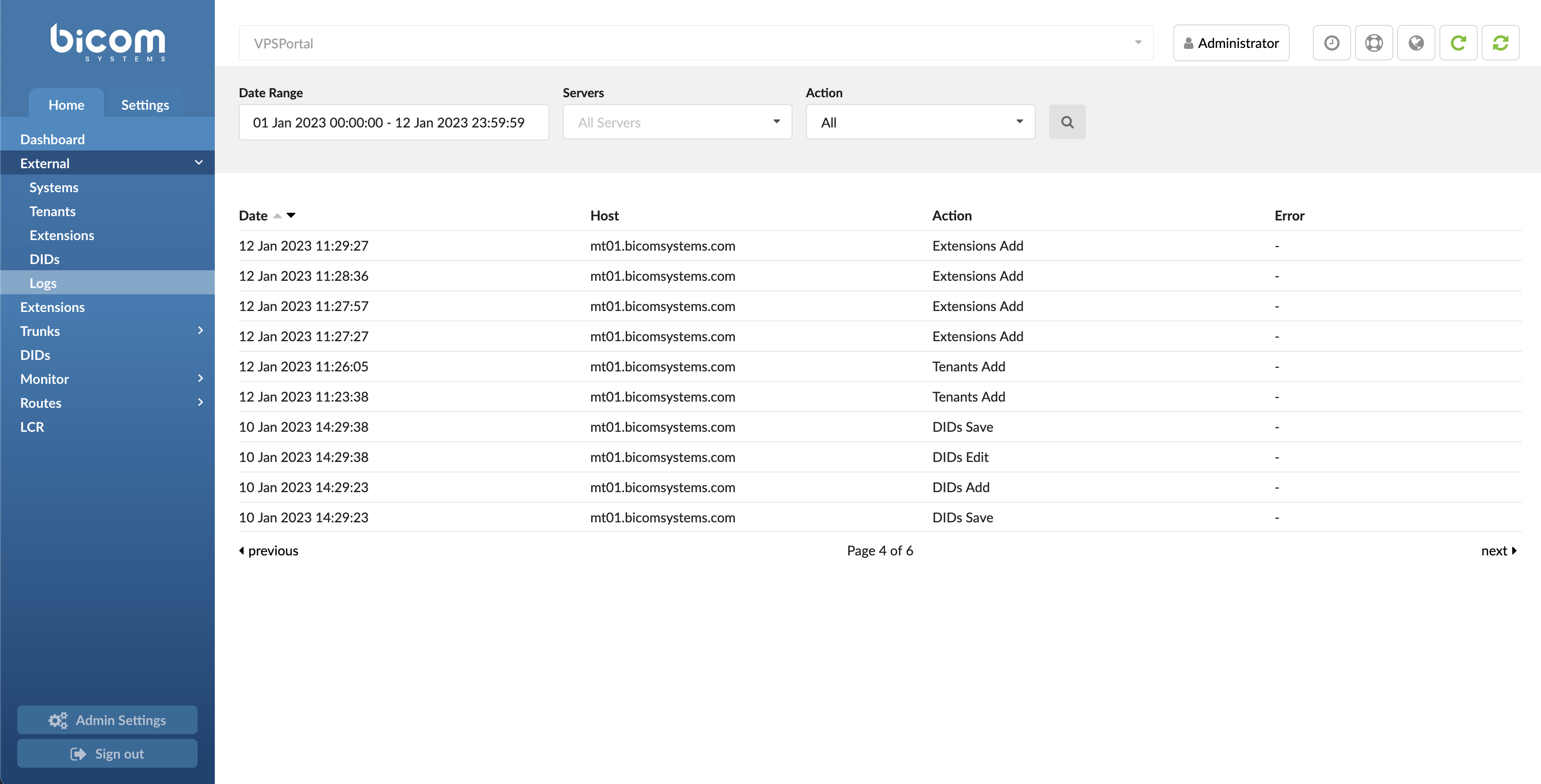
- Date Range
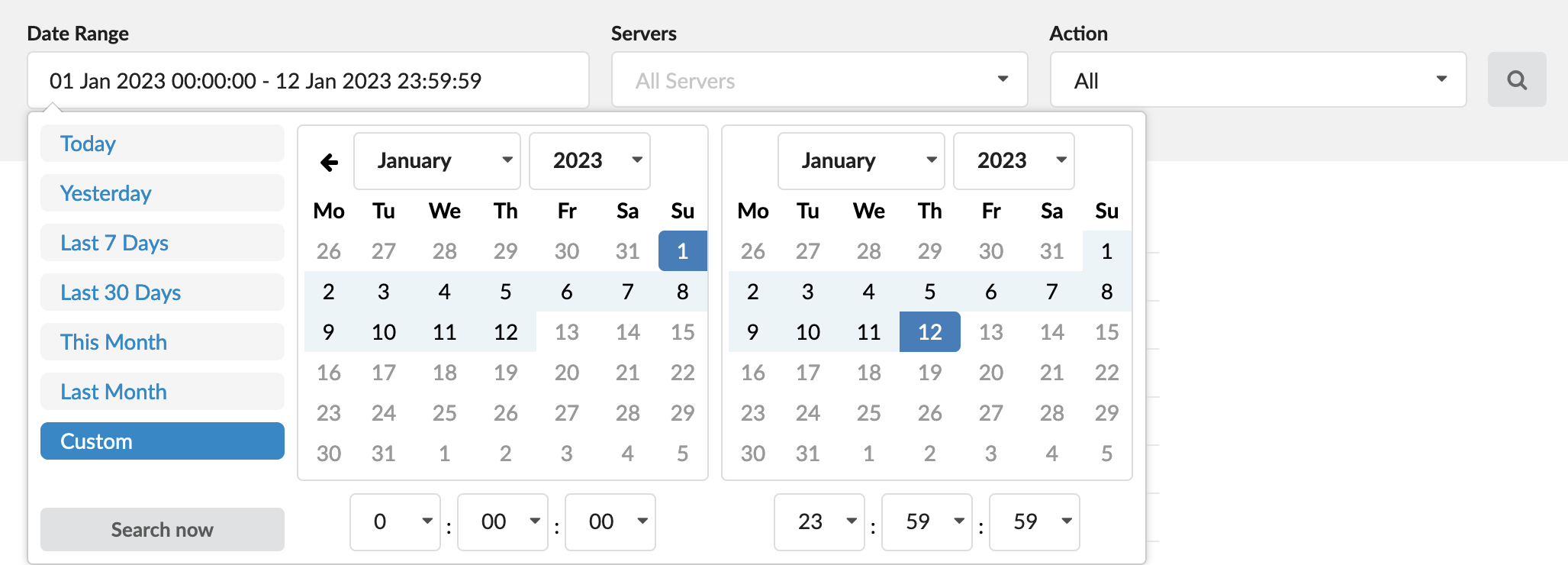
Date Range field allows you to filter syncing related logs based on date and time range. Default selection will be for the current date, from 00:00-23:59, but you can customize the time period by clicking on the Date Range field, which will open a date/time selection window.
Along with Custom search, which allows you to select any time period, by selecting start and end date, as well as start and end time. In addition, we have created few quick selections which will speed up the filtering process. Available quick selections are: Today, Yesterday, Last 7 Days, Last 30 Days, This Month and Last Month.
- Servers
To focus the search to logs related to specific server, you can select specific external system from the Servers drop down list to only display sync logs related to that external server.
- Action

By default, search will display logs related to all action types, but in case you would like to filter your search results based on specific action type, click in Action field and select prefered action type from the drop down list.
Once your search parameters are in place, press Search button to display the logs that match your selection.
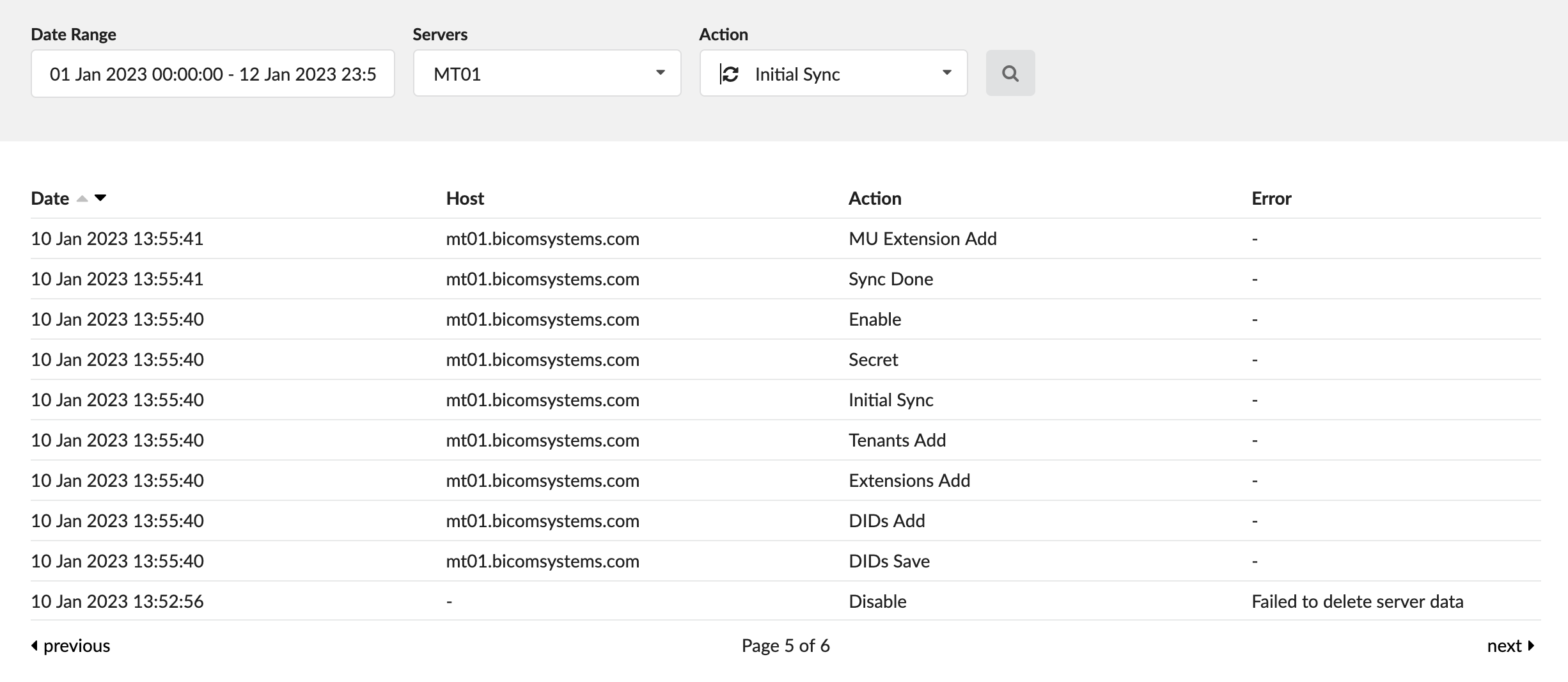
- Date
Date and time, log entry was made.
- Host
Domain name/IP Address of the external system log entry is related to.
- Action
Action type performed. For example, if you create a new extension on one of your external servers, that information will be synced to PBXware SP so you can edit that extension from PBXware SP interface. If sync is performed successfully action type in sync log entry will be "Extension Add".
- Error
If action is performed successfuly, log entry will have - in the Error column. However, in case of any issues, message describing specific issue will be displayed in the Error column.
